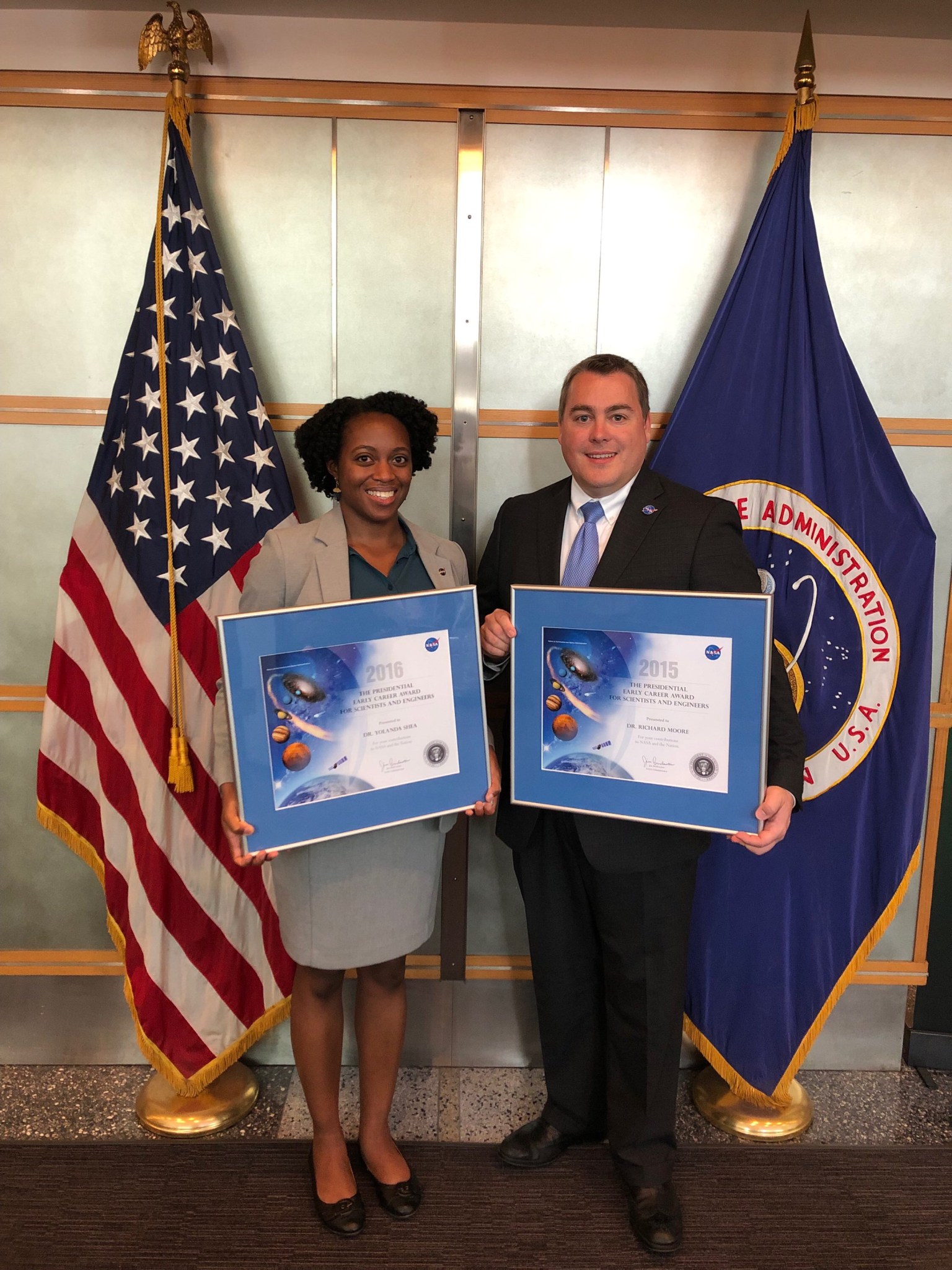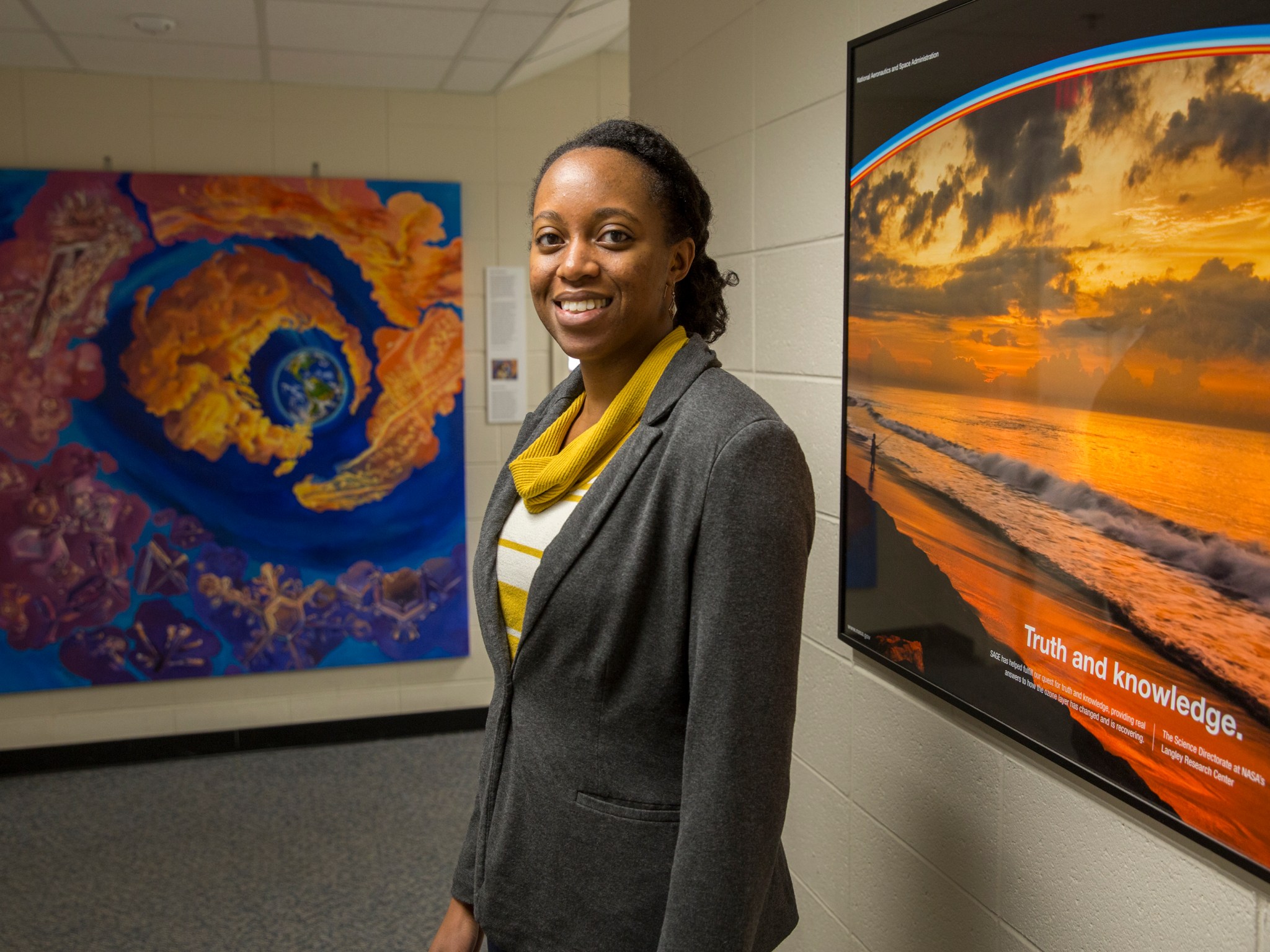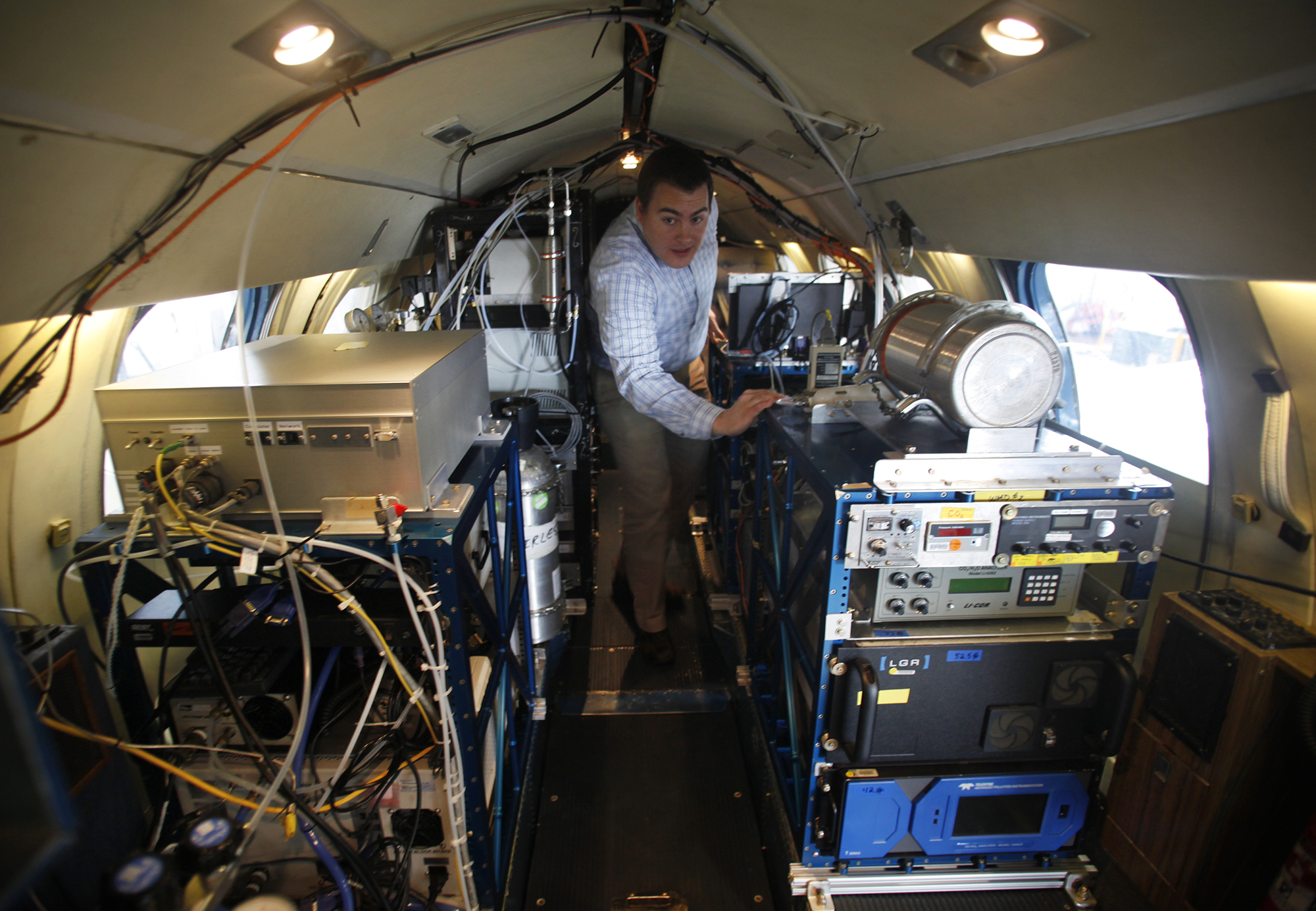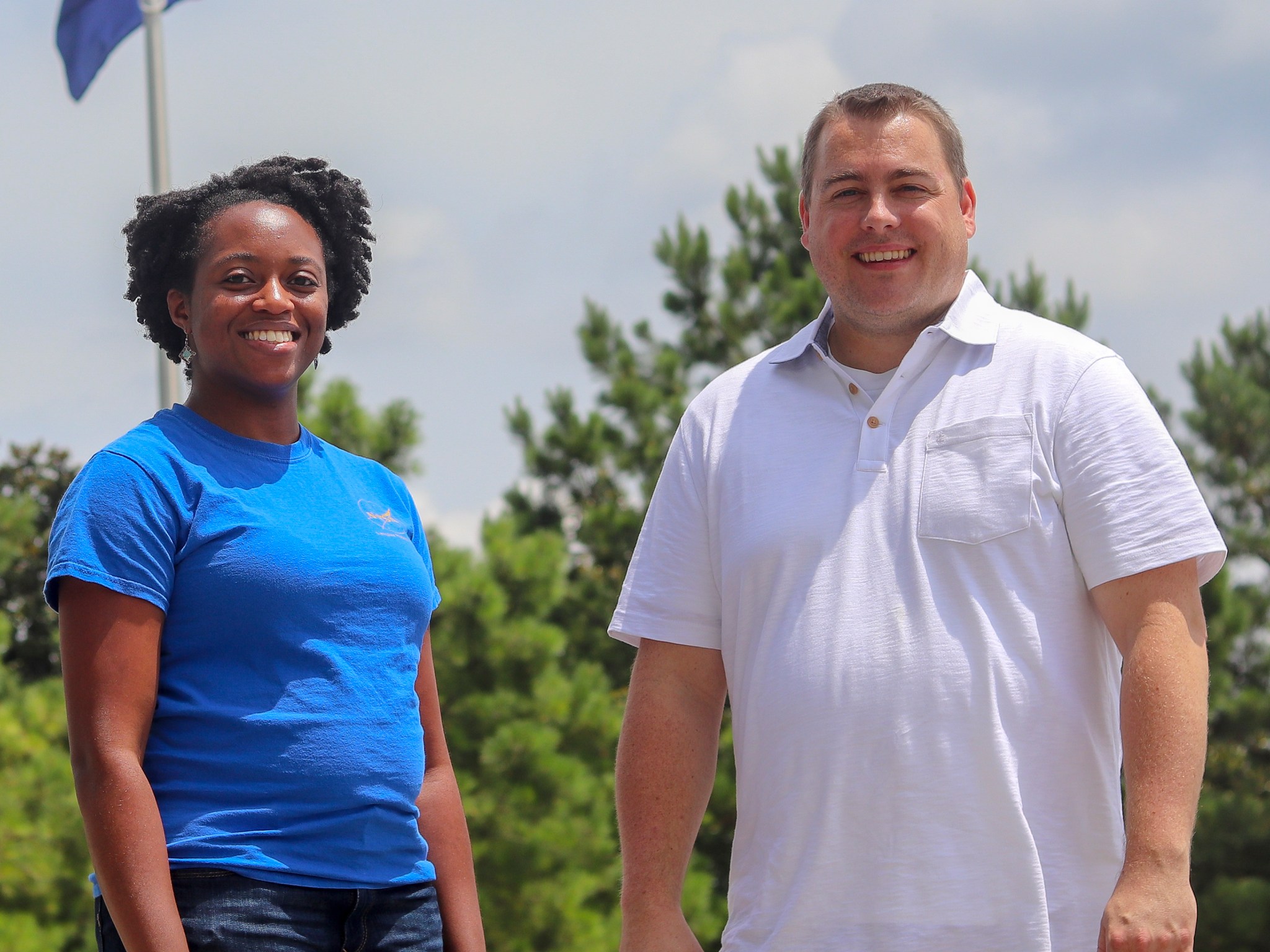Isaac Newton said, “If I have seen further it is by standing on the shoulders of giants.”
Mentors propel us forward in new directions, giving us hope for our futures, helping us remain grounded while reaching for our goals. NASA scientists Yolanda Shea and Rich Moore both credit mentorship during their graduate studies and their own eagerness to learn for the sound foundation that’s led to the incredible careers they enjoy today.
Yesterday, on July 25, 2019, Shea and Moore received a Presidential Early Career Award for Scientists and Engineers (PECASE). This extraordinary award is the highest honor bestowed by the U. S. government on outstanding scientists and engineers, meant to recognize exceptional potential for leadership at the frontier of scientific knowledge at the beginning of their research careers.
A person isn’t born an outstanding scientist though. Both Shea and Moore worked hard to reach where they are today, taking new paths that weren’t originally on their radar, leading to unique opportunities.
Piecing Together the Puzzle
During her childhood, Yolanda Shea moved to central Virginia from Massachusetts. “Being in a new place as a nine-year-old, thunderstorms seemed bigger and scarier than in Massachusetts for some reason,” said Shea. What began at first as a way to stay informed about the different weather patterns happening around her turned into an overall curiosity in meteorology. She became interested in how different puzzle pieces of weather information were combined to create a forecast.
“Those experiences got me interested in science, which eventually led me to working with satellite data,” explains Shea. Her focus is in shortwave spectral measurements, or measuring Earth-reflected sunlight to help monitor changes in our planet’s climate system. Through statistics, Shea parses through the information to learn about aspects of our atmosphere, like clouds, aerosols and water vapor.
As a graduate student, she became involved with a mission known as Climate Absolute Radiance and Refractivity Observatory (CLARREO). The CLARREO project focuses on producing reliable and accurate Earth climate data records. Shea continued working with this project after starting at NASA and now serves as project scientist for the CLARREO Pathfinder mission.
Shea currently investigates the accuracy of satellite measurements needed to detect changes in Earth’s climate. Her work will ensure that future researchers have the information needed to more confidently discern changes in Earth’s climate sooner than is currently possible.
Supporting Others to Enter Science
In addition to her research, Shea inspires the next generation of scientists and researchers through outreach events. In 2015, an opportunity with PBS Kids’ SciGirls allowed Shea to teach students how to identify clouds from the ground to help scientists validate their satellite cloud programs. “It was a lot of fun, especially because I grew up on PBS,” Shea said.
Being able to challenge ‘successful scientist’ stereotypes is one of the reasons Shea volunteers to do outreach. She wants kids to have more positive experiences with scientists than what she encountered at their age. By breaking molds of what a scientist looks like, Shea reaches students from various underrepresented groups, showing that at his or her core, a scientist is a person who works hard to learn about the world we live in.
Shea strongly believes that doing something fun doesn’t mean that the task is easy. Success doesn’t mean the job came naturally. “Just because it’s hard doesn’t mean you’re not good at it or that you won’t ever be successful at it,” said Shea. “It takes hard work to do fun but impactful things.”
“One thing people should realize is the importance of having mentors to support and advocate for you,” Shea said. While working on her Ph.D. program, Shea and three female peers in atmospheric science helped each other as all of them encountered both personal and professional challenges. Even though they were at slightly different stages of their careers, the women supported each other during their struggles.
Switching from Engineer to Scientist
Rich Moore walked a similar path; after completing his Bachelor’s degree in chemical engineering, he was looking for opportunities to continue his education. During Moore’s master’s program, one senior professor pointed him in the direction of new faculty member.
The younger, passionate academic introduced Moore to the world of aerosols, small particles suspended in the Earth’s atmosphere, working to quantify the mixtures and chemistries in the particles. Here, Moore’s career pivoted from a traditional chemical engineering path to atmospheric sciences.
Moore has been involved in a variety of airborne science campaigns since joining NASA and in a variety of roles. For the recent North Atlantic Aerosols and Marine Ecosystems Study (NAAMES), he worked to design flight plans to meet NASA’s science objectives, including flying under satellite orbit paths with the airplane to validate the satellite measurements.
Currently, Moore is operating a suite of instruments as part of an interagency mission known as Fire Influence on Regional to Global Environments and Air Quality (FIREX-AQ), studying the impact of wildfires and biomass smoke on air quality and weather in the continental United States.
Being an atmospheric research scientist, there is never a dull moment. Using multiple disciplines encourages continuous learning. “I went to school for traditional chemistry, but applying it to the work we’re doing at Langley gives me the opportunity to learn about different things,” says Moore.
Challenges of Science on An Airplane
When working an airborne campaign, Moore and other researchers have to bring their chemistry laboratory, which might have traditional instruments and techniques, and adapt it for science flights. Scientists collaborate with aerospace and mechanical engineers to fortify delicate equipment and create ways to collect data during an airborne campaign.
In addition to the engineering aspects, there are the actual flight plans. A science flight can be different from a commercial flight, reaching airspaces where pilots do not typically go. Before even turning on the plane, pilots have to determine a flight plan and have it approved by air traffic control. Planning three days prior to a flight, Moore often has to look at the forecast for the flight day, determine where the satellite will be overhead, and consider what conditions the researchers might want to measure—all to file the correct flight plan and clearance.
Neither mechanical engineering nor aircraft flight plans were among Moore’s traditional chemical engineering education, but working on projects with people from different backgrounds can bring interesting opportunities to learn. “Mobile aircraft labs represent a host of new challenges. Through interdisciplinary collaborating with engineers and pilots, I’m always learning about different things,” said Moore.
Looking Forward to the Future
There was a time when Shea was helping organize an early career event and needed cross-disciplinary panelists, and Rich Moore came to mind, not only because of his experience but also because he is a strong and engaging communicator. “He was able to share insights about interdisciplinary work, some of the challenges of it and his lessons learned with our participants attending the panel,” said Shea.
Being able to help others learn from experiences helps prepare upcoming researchers who might take a similar journey. Both Moore and Shea will continue to mentor the next scientists and engineers as they forge their own journeys in the discipline.
While they haven’t worked on any projects together, Moore and Shea are in the same building, just down the hall from each other. “Yolanda Shea is a great person here at Langley to share the honors of a PECASE award. The fact that we’re both receiving one makes the occasion much nicer,” said Moore.
Shea and Moore are both are appreciative and excited for this award that was presented to them yesterday at the White House. “It’s an incredible honor that our work and efforts are being acknowledged in this way,” said Shea.



























